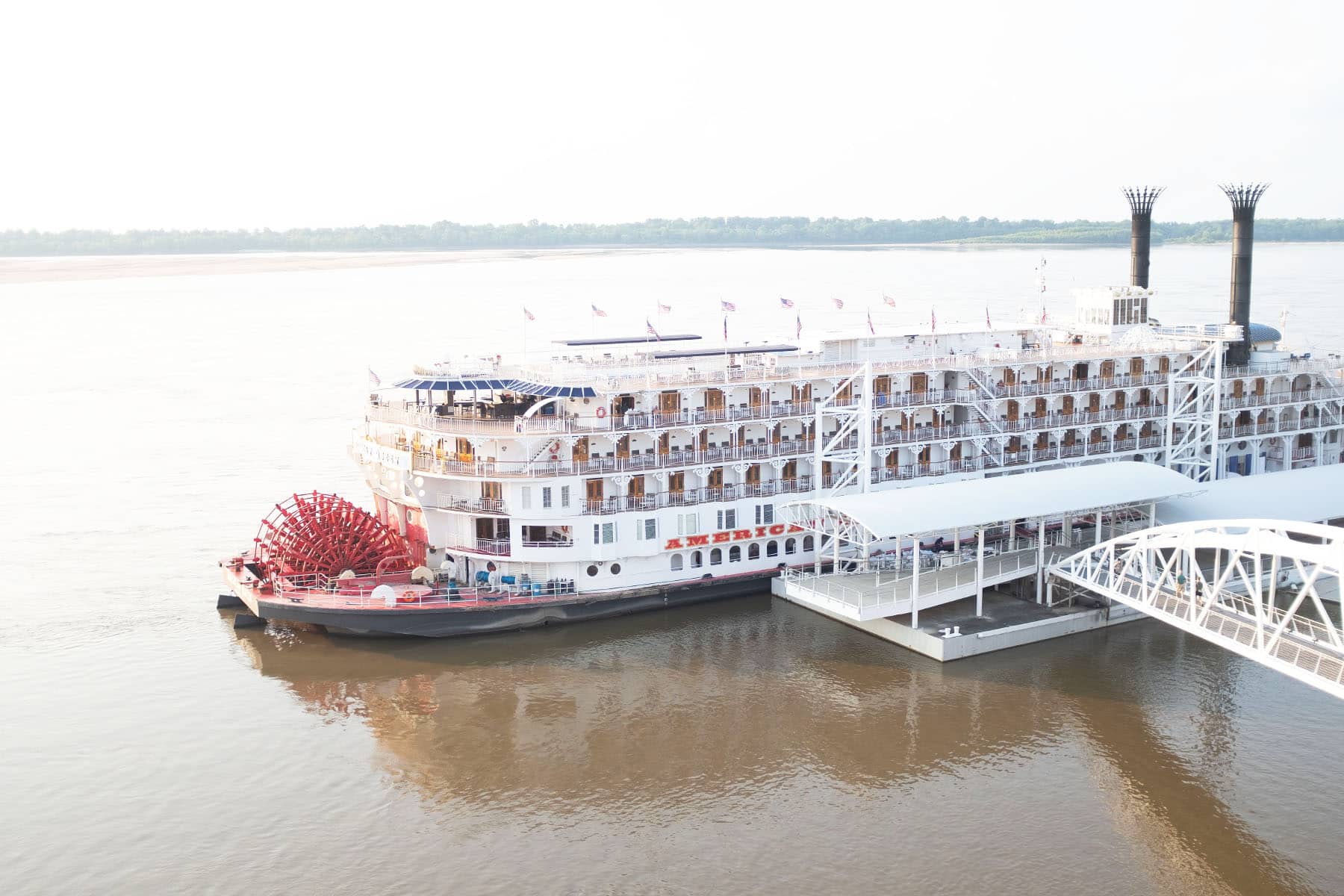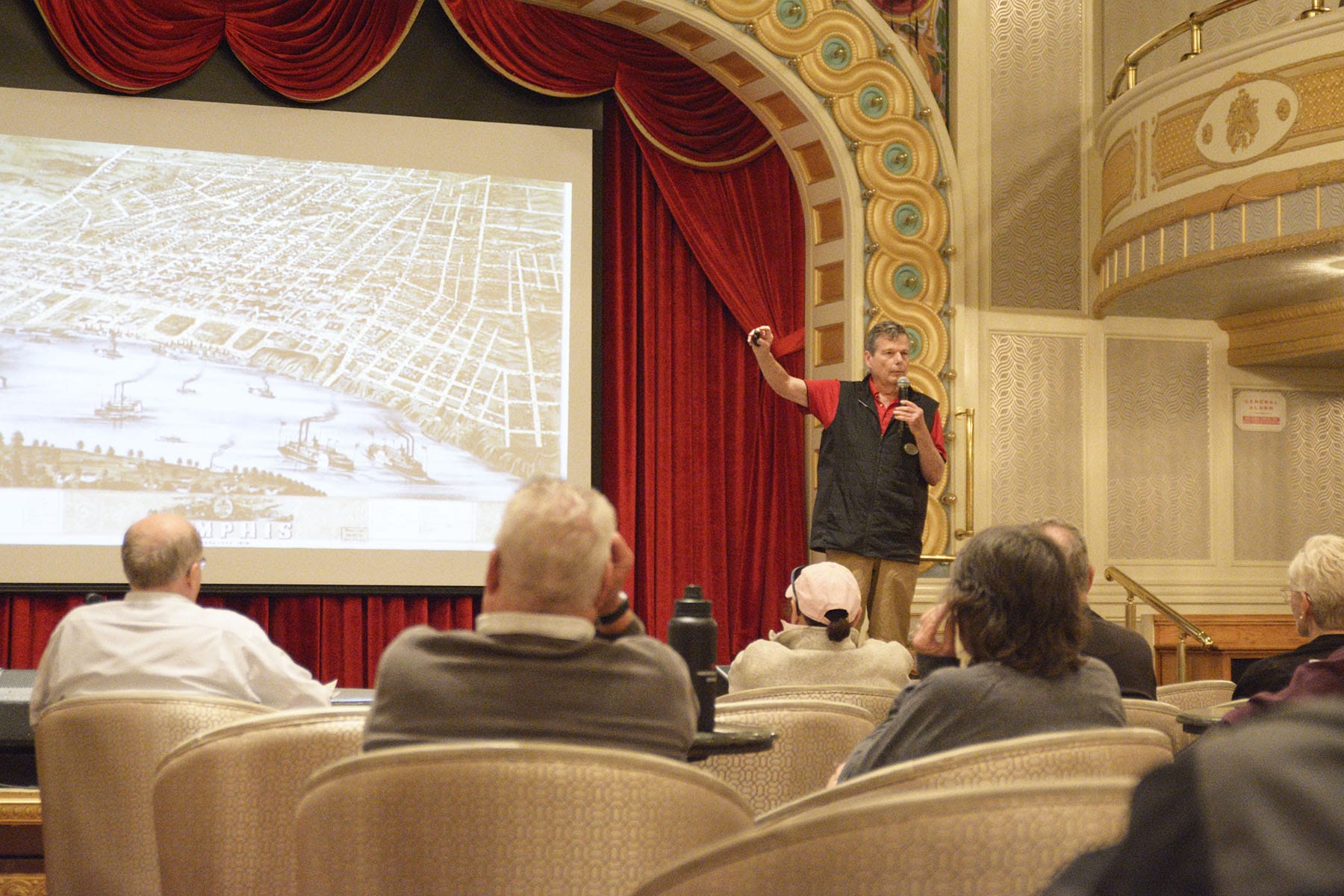Mississippi Today
History is huge draw for Mississippi River cruise goers, but whose history?

Overnight cruises returned to the Mississippi River a decade ago, following the industry’s collapse. As existing cruise lines adapt, and companies like Viking enter the market, many passengers say the river’s storied past is part of the draw.
But what history do they learn, and how?
On a hot afternoon in late May, Lee Hendrix stood on stage in the dimly lit Grand Saloon — an elaborate floating reproduction of the original Ford’s Theatre in Washington, D.C., where Abraham Lincoln was assassinated.
The former river captain and self-schooled historian described the sinking of the Sultana near Memphis more than 150 years ago, when at least 1,400 people drowned on the Mississippi River. A rapt crowd listened as their own vessel, the American Queen, mosied safely up the same route.
Hendrix is a riverlorian — think: river, lore and historian — aboard the American Queen, a steamboat that can haul more than 400 cruise-goers the length of the Mississippi River. This audience is nearing the end of a seven-day journey from New Orleans to Memphis.
This cruise line offers presentations about local history, as do all three overnight Mississippi River cruise lines — American Queen Voyages, American Cruise Lines and Viking. Some presenters are Ph.D. historians, and others are self-schooled, like Hendrix, who’s a veteran on the river.
The American Queen is billed as capturing the nostalgia of 19th century steamboat travel. The company prides itself on using a restored, century-old steam engine, and the sentiment extends to the rest of the vessel, which oozes with memorabilia of the period.

Passengers are greeted with red carpeted stairs at the bow of the boat, ending at a set of gilded double doors that open to the Mark Twain Gallery, a dimly-lit room lined with ornate bookshelves, steamboat replicas in glass cases and displays of Twain’s works.
Lower river tours with American Queen Voyages start at about $4,000 — well above the cost of an average Caribbean cruise — and the most expensive tickets come with a $10,000 price tag. They attract a crowd that’s mostly retired, wealthy and well-traveled, and history is part of the draw for many passengers.
The company’s strategy “is to identify thoughtful and deliberate shore excursions” and provide riverlorians to help guests understand the complexity of the region, Cindy D’Aoust, president of American Queen Voyages, said in a statement.. .
Most days, passengers can find Hendrix walking laps around the fourth floor deck of the American Queen or in the Chart Room — an airy room at the boat’s bow, filled with books and maps of the river — ready to answer passengers’ questions in between excursions in riverside towns.
But at a time when many plantations are facing scrutiny for not accurately representing the legacy of slavery in the South, historians like John Anfinson, a Ph.D. historian and riverlorian with American Cruise Lines, try to add context to these stops along the tour in a “Plantation Preview.”
Anfinson does his best to prepare tourists before they step off the boat, steering away from the history they often hear on guided tours and opting instead to describe the legacy of slavery in the South. That way, he said, people can make sense of the stories shared on tours in a meaningful way.
American Cruise Lines’ description of the Houmas House, one of the most notorious plantations of the South, reads: “Step off of your ship docked right at Houmas House and explore one of the most elaborately renovated of the grand homes along the river, once a private home and thriving historical agricultural enterprise.”
Anfinson read the description and exclaimed: “Talk about a way to avoid saying ‘plantation!’”
Houmas House is named after the indigenous Louisianans they stole the land from and was owned by Revolutionary War general Wade Hampton, one of the largest slaveholders in the antebellum South. In the same year he purchased Houmas House, he suppressed a slave revolt that resulted in the deaths of 95 enslaved people.
The Houmas House website does not mention this history, and Anfinson understands why not all historic sites lead with that.
“In the fractured America of today, the audience is going to be fractured in how they listen to that story,” Anfinson said.
The Laura Plantation, situated between New Orleans and Baton Rouge, was the first museum of its kind in the South that highlighted the lives of enslaved people when it opened in 1994. Operations manager Jay Schexnaydre said many other plantations have followed suit since then.
The Laura Plantation prides itself on taking guests through the house, grounds and slave quarters, compared to some other plantations that keep visitors in “the big house.” Some plantations still choose to showcase the grandeur of Antebellum homes on plantation tours, focusing on antique furniture and portraits.
“What people are interested in is the truth,” Schexnaydre said.
American Queen Voyages and Viking feature the Laura Plantation on their itineraries, but Schexnaydre said the logistics of tours can impact visitors’ experiences.
If passengers start their tour in New Orleans, the Laura Plantation is one of their first stops. If their tour starts in Memphis, heading downriver, Schexnaydre said passengers likely will spend the last week touring other plantations, and might opt for an alternate excursion instead.
“Every stop is plantations, plantations, plantations,” he said.
Part of the Laura Plantation’s tour follows the arc of one family over three generations rather than telling the stories of enslaved people in a general sense. Schexnaydre said it helps visitors connect more intimately with people whose stories might otherwise be lost to history.

Riverlorian Hendrix makes an effort to confront forgotten history in his 45-minute lecture about the Sultana — a maritime disaster that rivals the death toll from the Titanic. He talked about how commercial navigation impacted indigenous peoples; the neglect of a steamboat captain who overcrowded the Sultana for profit; and the prisoners of war who died in the fiery explosion.
The story of the Sultana was lost in headlines about the killing of Lincoln’s assassin John Wilkes Booth and other events as the war neared its end, but Hendrix said it’s more than that.
“So, why doesn’t anybody know about the Sultana?” Hendrix wondered aloud on stage. “The people on the Sultana were poor soldiers returning home. Most of the people on the Titanic were rich people.”
Anfinson and Hendrix know some passengers will skip their talks. Some people are celebrating a birthday or anniversary, Anfinson said; not everyone is there for a history lesson. In many ways, it’s up to passengers to craft their experiences, but the histories that passengers encounter often depend on who’s telling them, and how.
Hendrix became a riverlorian after decades on the river, first as a deckhand and then as a river pilot, with a brief stint away that involved performing skits where he played a steamboat captain. He said he’s always loved river history, “probably more so than other pilots.”
By the time passengers heard Hendrix’s recollection of the Sultana’s sinking, they had stopped at ports in Nottoway, St. Francisville, Natchez and Vicksburg. In St. Francisville, passengers could choose between two excursions: “Plantations of the Back Roads” or “Redemption and Rehabilitation at Angola Prison.”
The Louisiana State Penitentiary — more often called Angola, for the former slave plantation that occupied the land — is the largest maximum-security prison in the country. Under the convict lease system, prisoners were abused, underfed and worked to death during much of the 19th and early 20th centuries, and it earned a reputation as “the bloodiest prison in the South.”
The Angola Museum included on the cruise line’s itinerary tries to tell “the complex and compelling stories of corrections and justice in Louisiana.” Visitors tour through the prison’s infamous past, including a stop at the Red Hat Cell Block, adjacent to a small room that was the site of 11 executions by electric chair between 1956 and 1961.
The prison now touts a philosophy of moral rehabilitation, though it continues to come under fire for involuntary servitude. The tour brings visitors to the present-day with a tour of the crop fields, where prisoners grow the food they eat.
American Queen passenger Jennifer White Fischer felt she left the tour with a more nuanced understanding of the criminal justice system. But then, she said tour guides at the nearby Louisiana State University Rural Life Museum raised critical questions about Angola she hadn’t considered.
As someone who discovered her love of history later in life, and recently wrote a book about her travels, she prioritizes the educational excursions on her tours.
“(River cruises) have just opened my eyes to the whole vastness of our country,” she said.
About halfway through the cruise from New Orleans to Memphis, passengers spent an afternoon in Vicksburg, Mississippi. The itinerary featured mainstays like the Jesse Brent Lower Mississippi River Museum and the Vicksburg National Military Park, but a more recent addition to the lineup tells Civil War history in a different way.
Charles Pendleton opened the Vicksburg Civil War Museum two years ago to talk about the war from a Black perspective.
“You open something like this, and all of the factors are not in your favor,” Pendleton said. “You’re Black, you’re in Vicksburg, Mississippi, where everybody has deep feelings about the Confederacy…and here you are telling a different story.”
A self-made historian, Pendleton started out attending Civil War gun shows, where he said white attendees made a point to tout their own theories about the war. It was the impetus for his own research, which led to him sharing presentations at his church.
Then, he stumbled across more Civil War-era memorabilia at antique shops, including a receipt for a seven-year-old girl named Ella. It elicited an emotional response he hadn’t experienced at other Civil War museums, and he wanted to capture that emotion for other museum-goers in Vicksburg.
Pendleton said most visitors are white and estimates at least half come from river cruises, which he said have been a boon for his museum and other small businesses. As cruise lines add new boats to their fleets and more stops to their itineraries, Pendleton hopes the industry will continue to elevate voices like his.
This story, the first of a three-part series, published in partnership with the Mississippi Center for Investigative Reporting, part of Mississippi Today, is a product of the Mississippi River Basin Ag & Water Desk, an independent reporting network based at the University of Missouri in partnership with Report for America, funded by the Walton Family Foundation.
This article first appeared on Mississippi Today and is republished here under a Creative Commons license.
Mississippi Today
Mississippi River flooding Vicksburg, expected to crest on Monday
Warren County Emergency Management Director John Elfer said Friday floodwaters from the Mississippi River, which have reached homes in and around Vicksburg, will likely persist until early May. Elfer estimated there areabout 15 to 20 roads underwater in the area.
“We’re about half a foot (on the river gauge) from a major flood,” he said. “But we don’t think it’s going to be like in 2011, so we can kind of manage this.”
The National Weather projects the river to crest at 49.5 feet on Monday, making it the highest peak at the Vicksburg gauge since 2020. Elfer said some residents in north Vicksburg — including at the Ford Subdivision as well as near Chickasaw Road and Hutson Street — are having to take boats to get home, adding that those who live on the unprotected side of the levee are generally prepared for flooding.



“There are a few (inundated homes), but we’ve mitigated a lot of them,” he said. “Some of the structures have been torn down or raised. There are a few people that still live on the wet side of the levee, but they kind of know what to expect. So we’re not too concerned with that.”
The river first reached flood stage in the city — 43 feet — on April 14. State officials closed Highway 465, which connects the Eagle Lake community just north of Vicksburg to Highway 61, last Friday.

Elfer said the areas impacted are mostly residential and he didn’t believe any businesses have been affected, emphasizing that downtown Vicksburg is still safe for visitors. He said Warren County has worked with the U.S. Army Corps of Engineers and the Mississippi Emergency Management Agency to secure pumps and barriers.
“Everybody thus far has been very cooperative,” he said. “We continue to tell people stay out of the flood areas, don’t drive around barricades and don’t drive around road close signs. Not only is it illegal, it’s dangerous.”
NWS projects the river to stay at flood stage in Vicksburg until May 6. The river reached its record crest of 57.1 feet in 2011.




This article first appeared on Mississippi Today and is republished here under a Creative Commons Attribution-NoDerivatives 4.0 International License.![]()
Mississippi Today
With domestic violence law, victims ‘will be a number with a purpose,’ mother says
Joslin Napier. Carlos Collins. Bailey Mae Reed.
They are among Mississippi domestic violence homicide victims whose family members carried their photos as the governor signed a bill that will establish a board to study such deaths and how to prevent them.
Tara Gandy, who lost her daughter Napier in Waynesboro in 2022, said it’s a moment she plans to tell her 5-year-old grandson about when he is old enough. Napier’s presence, in spirit, at the bill signing can be another way for her grandson to feel proud of his mother.
“(The board) will allow for my daughter and those who have already lost their lives to domestic violence … to no longer be just a number,” Gandy said. “They will be a number with a purpose.”
Family members at the April 15 private bill signing included Ashla Hudson, whose son Collins, died last year in Jackson. Grandparents Mary and Charles Reed and brother Colby Kernell attended the event in honor of Bailey Mae Reed, who died in Oxford in 2023.
Joining them were staff and board members from the Mississippi Coalition Against Domestic Violence, the statewide group that supports shelters and advocated for the passage of Senate Bill 2886 to form a Domestic Violence Facility Review Board.
The law will go into effect July 1, and the coalition hopes to partner with elected officials who will make recommendations for members to serve on the board. The coalition wants to see appointees who have frontline experience with domestic violence survivors, said Luis Montgomery, public policy specialist for the coalition.
A spokesperson from Gov. Tate Reeves’ office did not respond to a request for comment Friday.
Establishment of the board would make Mississippi the 45th state to review domestic violence fatalities.
Montgomery has worked on passing a review board bill since December 2023. After an unsuccessful effort in 2024, the coalition worked to build support and educate people about the need for such a board.
In the recent legislative session, there were House and Senate versions of the bill that unanimously passed their respective chambers. Authors of the bills are from both political parties.
The review board is tasked with reviewing a variety of documents to learn about the lead up and circumstances in which people died in domestic violence-related fatalities, near fatalities and suicides – records that can include police records, court documents, medical records and more.
From each review, trends will emerge and that information can be used for the board to make recommendations to lawmakers about how to prevent domestic violence deaths.
“This is coming at a really great time because we can really get proactive,” Montgomery said.
Without a board and data collection, advocates say it is difficult to know how many people have died or been injured in domestic-violence related incidents.
A Mississippi Today analysis found at least 300 people, including victims, abusers and collateral victims, died from domestic violence between 2020 and 2024. That analysis came from reviewing local news stories, the Gun Violence Archive, the National Gun Violence Memorial, law enforcement reports and court documents.
Some recent cases the board could review are the deaths of Collins, Napier and Reed.
In court records, prosecutors wrote that Napier, 24, faced increased violence after ending a relationship with Chance Fabian Jones. She took action, including purchasing a firearm and filing for a protective order against Jones.
Jones’s trial is set for May 12 in Wayne County. His indictment for capital murder came on the first anniversary of her death, according to court records.
Collins, 25, worked as a nurse and was from Yazoo City. His ex-boyfriend Marcus Johnson has been indicted for capital murder and shooting into Collins’ apartment. Family members say Collins had filed several restraining orders against Johnson.
Johnson was denied bond and remains in jail. His trial is scheduled for July 28 in Hinds County.
He was a Jackson police officer for eight months in 2013. Johnson was separated from the department pending disciplinary action leading up to immediate termination, but he resigned before he was fired, Jackson police confirmed to local media.
Reed, 21, was born and raised in Michigan and moved to Water Valley to live with her grandparents and help care for her cousin, according to her obituary.
Kylan Jacques Phillips was charged with first degree murder for beating Reed, according to court records. In February, the court ordered him to undergo a mental evaluation to determine if he is competent to stand trial, according to court documents.
At the bill signing, Gandy said it was bittersweet and an honor to meet the families of other domestic violence homicide victims.
“We were there knowing we are not alone, we can travel this road together and hopefully find ways to prevent and bring more awareness about domestic violence,” she said.
This article first appeared on Mississippi Today and is republished here under a Creative Commons Attribution-NoDerivatives 4.0 International License.
Mississippi Today
Court to rule on DeSoto County Senate districts with special elections looming
A federal three-judge panel will rule in coming days on how political power in northwest Mississippi will be allocated in the state Senate and whether any incumbents in the DeSoto County area might have to campaign against each other in November special elections.
The panel, comprised of all George W. Bush-appointed judges, ordered state officials last week to, again, craft a new Senate map for the area in the suburbs of Memphis. The panel has held that none of the state’s prior maps gave Black voters a realistic chance to elect candidates of their choice.
The latest map proposed by the all-Republican State Board of Election Commissioners tweaked only four Senate districts in northwest Mississippi and does not pit any incumbent senators against each other.
The state’s proposal would keep the Senate districts currently held by Sen. Michael McLendon, a Republican from Hernando and Sen. Kevin Blackwell, a Republican from Southaven, in majority-white districts.
But it makes Sen. David Parker’s district a slightly majority-Black district. Parker, a white Republican from Olive Branch, would run in a district with a 50.1% black voting-age population, according to court documents.
The proposal also maintains the district held by Sen. Reginald Jackson, a Democrat from Marks, as a majority-Black district, although it reduces the Black voting age population from 61% to 53%.
Gov. Tate Reeves, Secretary of State Michael Watson, and Attorney General Lynn Fitch comprise the State Board of Election Commissioners. Reeves and Watson voted to approve the plan. But Watson, according to meeting documents, expressed a wish that the state had more time to consider different proposals.
Fitch did not attend the meeting, but Deputy Attorney General Whitney Lipscomb attended in her place. Lipscomb voted against the map, although it is unclear why. Fitch’s office declined to comment on why she voted against the map because it involves pending litigation.
The reason for redrawing the districts is that the state chapter of the NAACP and Black voters in the state sued Mississippi officials for drawing legislative districts in a way that dilutes Black voting power.
The plaintiffs, represented by the ACLU, are likely to object to the state’s newest proposal, and they have until April 29 to file an objection with the court
The plaintiffs have put forward two alternative proposals for the area in the event the judges rule against the state’s plans.
The first option would place McLendon and Blackwell in the same district, and the other would place McLendon and Jackson in the same district.
It is unclear when the panel of judges will issue a ruling on the state’s plan, but they will not issue a ruling until the plaintiffs file their remaining court documents next week.
While the November election is roughly six months away, changing legislative districts across counties and precincts is technical work, and local election officials need time to prepare for the races.
The judges have not yet ruled on the full elections calendar, but U.S. Fifth Circuit Court of Appeals Judge Leslie Southwick said at a hearing earlier this month that the panel was committed have the elections in November.
This article first appeared on Mississippi Today and is republished here under a Creative Commons Attribution-NoDerivatives 4.0 International License.
-

 News from the South - Florida News Feed6 days ago
News from the South - Florida News Feed6 days agoJim talks with Rep. Robert Andrade about his investigation into the Hope Florida Foundation
-

 News from the South - Virginia News Feed7 days ago
News from the South - Virginia News Feed7 days agoHighs in the upper 80s Saturday, backdoor cold front will cool us down a bit on Easter Sunday
-

 News from the South - Arkansas News Feed7 days ago
News from the South - Arkansas News Feed7 days agoValerie Storm Tracker
-

 News from the South - Kentucky News Feed7 days ago
News from the South - Kentucky News Feed7 days agoU.S. Supreme Court pauses deportations under wartime law
-

 Mississippi Today5 days ago
Mississippi Today5 days ago‘Trainwreck on the horizon’: The costly pains of Mississippi’s small water and sewer systems
-

 News from the South - Alabama News Feed4 days ago
News from the South - Alabama News Feed4 days agoPrayer Vigil Held for Ronald Dumas Jr., Family Continues to Pray for His Return | April 21, 2025 | N
-

 News from the South - Texas News Feed5 days ago
News from the South - Texas News Feed5 days agoMeteorologist Chita Craft is tracking a Severe Thunderstorm Warning that's in effect now
-

 Mississippi Today7 days ago
Mississippi Today7 days agoOn this day in 1977, Alex Haley awarded Pulitzer for ‘Roots’














































